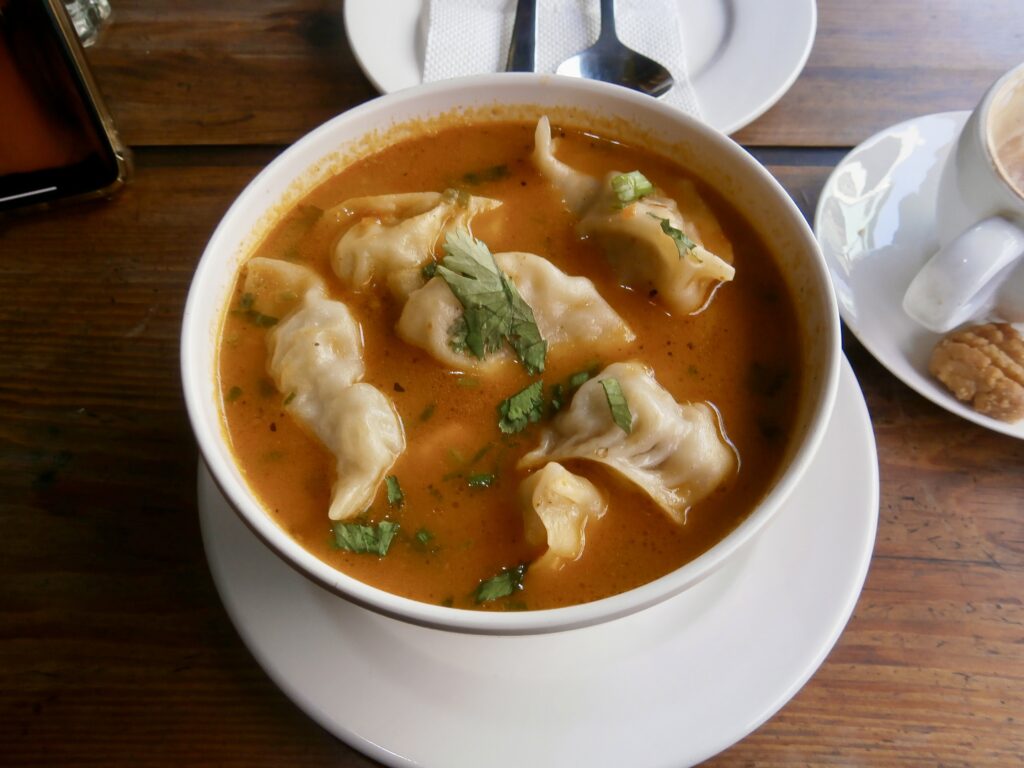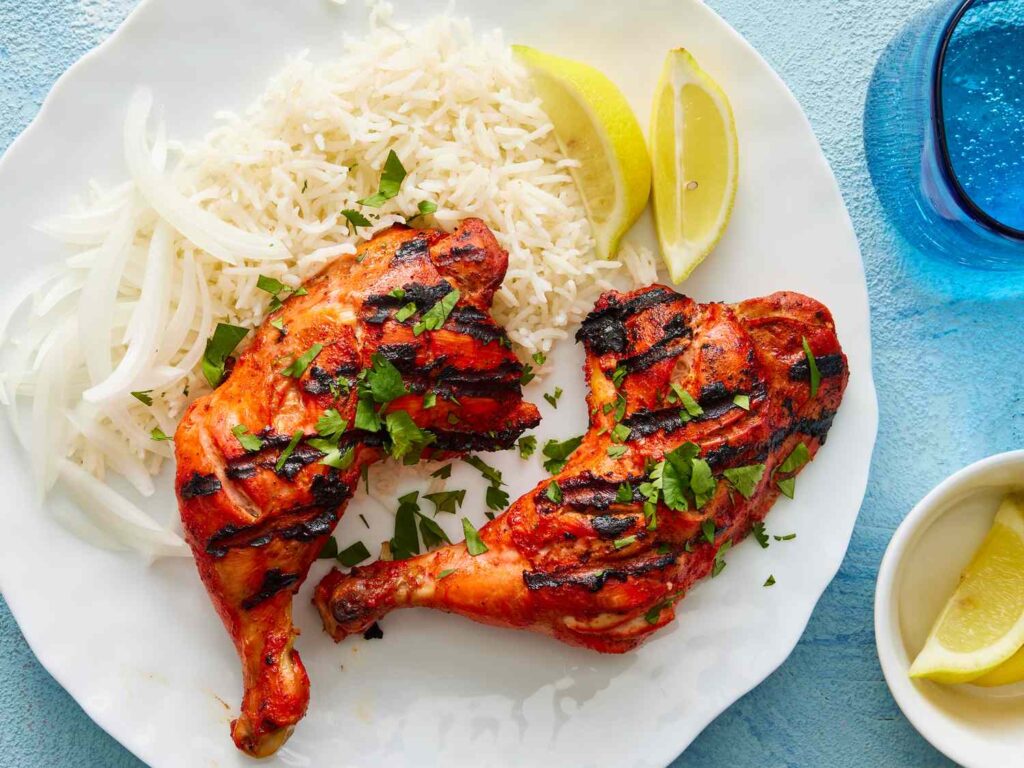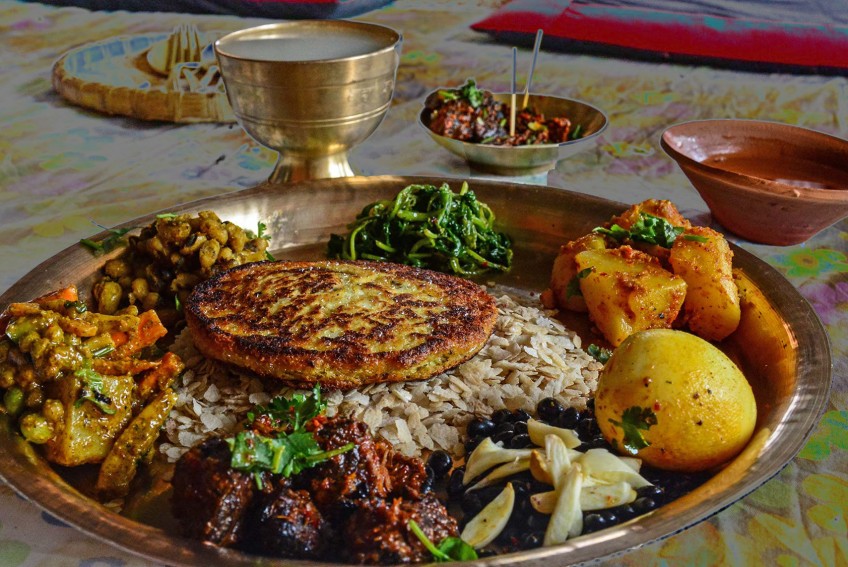Welcome to the Nepali Food Guide: A Culinary Adventure! Prepare for a tasty trip across Nepal’s unique and colorful cuisine. In this blog, you will look at the diverse flavors, spices, dishes and culinary traditions that distinguish Nepal’s gastronomic landscape. Whether you’re a seasoned foodie or an inquisitive visitor looking to try new flavors, join us as we investigate the wonders of Nepali cuisine and discover hidden jewels that will excite your taste buds. Prepare for a culinary adventure like no other!
Dal Bhat: Nepal’s Hearty National Dish
Dal Bhat, also known as ‘lentil soup’ (Dal) and ‘boiled rice’ (Bhat), is a popular meal in the Himalayas and the unofficial national cuisine of Nepal. It is typically accompanied by seasonal vegetable curry (Dal Bhat Tarkari), sautéed spinach (Saag), and optional curry beef. Common meats include chicken, buffalo, goat (mutton), or fish, served with delicious gravy. Achar, a spicy pickle, and hot tomato sauce complement the meal. It is often accompanied by curd or yogurt. Dal Bhat is a balanced, affordable, and healthy meal that has provided nutrition to Sherpas and hikers in the Himalayas for decades.

This comforting dish combines flavors and warmth, making it perfect for chilly days. Rice, either boiled or steamed, forms the centerpiece. It is usually surrounded by lentils, various curries, achars, or chutneys. Nepalese enjoy Dal Bhat daily for its balanced nutrition, with lentils offering health benefits. It is easy to prepare, captures the spirit of Nepalese cuisine, and can be found in practically every restaurant and hotel in Nepal.
Some of the Best Restaurants in Kathmandu to Try Dal Bhat:
Nepal’s Beloved Dumplings: Momo
Tibetan and Nepali cuisine offer momo, steamed dumplings packed with savory goodness. These delightful pockets come in small, round shapes or resemble half-moons. Traditionally, momo fillings feature minced meat like chicken, pork, or lamb. However, vegetarian options are also popular, featuring ingredients like spinach, carrot, cabbage, or potato.
Making momo starts with a simple dough of flour, water, and salt. The dough is then rolled out and filled with your chosen ingredients. After folding the edges, the momo are either steamed or fried for a delicious finish. To complete the experience, momo are typically served with a variety of sauces and toppings.
What distinguishes momos are their tasty fillings. Meat fillings are seasoned with spices, garlic, and onions, while vegetarian options include a combination of vegetables and paneer. Momos are further enhanced by complementing condiments such as achar and chutney, which add to their exquisite flavor.
The Most Popular Types of Momo:
- Steamed Momo: The classic type of momo. Steamed momo are commonly available in Nepalese restaurants and cafes. These delightful dumplings are filled with juicy minced vegetables or meat and steamed for an enjoyable meal.
- Fried Momo: Enjoy the crispy delight of fried momos, crafted by deep-frying or pan-frying after steaming. While they may be a tad oily, their irresistible taste will whisk you away from any health-conscious worries in no time!
- Kothey Momo: These momo are made in a half-moon shape. It’s a half-fried, half-steamed momo. The filling can be vegetables or different types of meat. This momo is most commonly available in chicken, buffalo, and pork.
- Chilly Momo: Introducing the fiery favorite, Chilly Momo. It’s the classic momo, dipped in a bold and spicy sauce, ideal for satisfying those craving some heat. Give it a try, we guarantee you’ll fall in love. Just be ready for a spicy adventure—it’s not for the faint of heart!
- Jhol Momo: These are the classic momo, served in a flavorful broth infused with spicy achar sauce. Some people also call it momo soup. A popular winter dish, especially in Nepal’s capital, Kathmandu. You can see Jhol Momo in a picture below.

Some of the Best Restaurants in Kathmandu to Try Momo:
- Aambo Momo.
- Thamel Momo Hut.
- Yangling Tibetan Restautant.
- Little Buddha Restaurant.
- Dechenling Garden Restaurant.
Thukpa: Nepal’s Comforting Noodle Soup
Thukpa, originating from eastern Tibet, is a traditional noodle soup. It encompasses a variety of soup or stew combinations with noodles. In Tibetan tradition, there are many different types of Thukpa, such as Thentuk (hard-pulled noodle), Gyathuk (Chinese noodle), Nepali, Pathug (hand-rolled pinched noodle), and Drethug.

Some of the Best Restaurants in Kathmandu to Try Thukpa:
Chow Mein: A Popular Stir-Fried Noodle Dish
Chow mein, originating from China, enjoys significant popularity throughout Nepal, despite not being a traditional Nepali dish. If you’re exploring Nepal, it’s a culinary delight worth experiencing. It consists of stir-fried noodles with vegetables and, optionally, meat or tofu. Throughout China’s regions, variations of chow mein have emerged, featuring diverse frying techniques and a variety of toppings.

Some of the Best Restaurants in Kathmandu to Try Chow Mein:
Biryani: Aromatic Secrets
Biryani is more than just a mixed-rice dish. It’s a culinary journey through the vibrant flavors of South Asia. This delightful masterpiece features fluffy basmati rice as its foundation, carefully layering aromatic spices with your choice of meat, eggs, or vegetables. The options range from tender lamb pieces to vibrant vegetable mixtures.
Biryani’s history is as rich as its taste. Once considered a dish only for kings and queens, it’s now loved by people all over India and beyond. Explore the wide variety of versions, each with its special touch:
- Sindhi Biryani: This yogurt-infused version offers a cool and creamy counterpoint to the warm spices.
- Bombay Biryani: A symphony of bold spices with a touch of kewra floral water, creating a truly unforgettable aroma.
- Lucknowi Biryani: Famous for its meticulous cooking technique, it layers and cooks meat and rice separately before combining them for a truly harmonious dish.

Biryani’s journey doesn’t stop at borders. The origins of biryani can be traced back to ancient Persia (modern-day Iran), where a similar dish called pilaf was prepared. However, biryani stands out with its unique blend of spices, often including cardamom, cinnamon, bay leaves, coriander, and mint. This harmonious blend of flavors elevates biryani to the top of the list for foodies all over the world.
Some of the Best Restaurants in Kathmandu to Try Biryani:
- Tasneem’s Kings Kitchen.
- Nepalaya Rooftop Restaurant.
- Mughal Biryani House (Durbar Marg, Kathmandu).
Chatamari (aka Nepali Pizza)
This Newari snack, also known as Nepali pizza, has a taste that is quite different from pizza. A rice flour crepe tops with coriander, minced meat, eggs, chopped onions, chilies, and a variety of spices. Its round shape and appearance classify it as a type of pizza. This is a must-try dish that stands out from the rest of Nepal’s cuisine. It can be served as an appetizer, a snack, or as the main dish.
Chatamari is especially popular during celebrations and similar festive occasions.

Some of the Best Restaurants in Kathmandu to Try Chatamari:
Chicken Tandoori: Where Tender Meets Spicy
Tandoori chicken is marinated in yogurt and spices before being roasted in a cylindrical clay oven known as a tandoor. It originated in India and has grown in popularity around the world, particularly since the late 1940s, when the Moti Mahal restaurant in New Delhi introduced it. Tandoori chicken is a versatile dish that can be enjoyed as a starter, appetizer, or main course, and is frequently served with naan flatbread. Its popularity extends to serving as a base for a variety of cream-based curries, including butter chicken.

Some of the Best Restaurants in Kathmandu to Try Chicken Tandoori:
- Tasneem’s Kings Kitchen.
- Third Eye Restaurant.
- Mint Cafe And Tandoori House.
- Anatolia Halal Food Restaurant.
Samay Baji: A Symphony of Flavors
Samay baji, a cherished traditional dish of Nepal’s Newar community, holds a special place in Nepalese cuisine. Passed down through generations, it’s a staple at celebrations, festivals, and religious events. Enjoyed year-round for its simplicity and storability, it’s a must-have during major festivals like Indra Jatra, Dashain, and Tihar.

Samay Baji is more than just a meal; it’s a rich tapestry of flavors and blessings. The vibrant platter of this traditional Newari dish features symbolic ingredients representing good fortune, health, longevity, and prosperity.
Furthermore, the Samay Baji presents two distinct textural experiences: baji (pounded rice) for earthiness and samay (puffed rice) for a light and airy counterpoint. These delicious accompaniments seamlessly complement the main components:
- Mari bread: A savory lentil patty, adding a satisfying protein element.
- Fried soybeans: Crunchy and protein-rich, symbolizing abundance.
- Fresh ginger: A zesty bite to cleanse the palate.
- Broiled and marinated meat: A celebratory addition, often representing prosperity.
- Dried fish: A nod to preservation and a source of essential nutrients.
- Fresh fruits: A vibrant touch of sweetness and seasonal variation.
- Savory lentil patties: Another protein source, highlighting the importance of lentils in the Newari diet.
- Ailaa: A local white wine, completing the celebratory nature of the meal.

Samay Baji goes beyond its culinary role. It’s a feast for the senses, a symbol of good fortune, and an illustration of the Newari people’s diverse cultural traditions.
Some of the Best Restaurants in Kathmandu to Try Samay Baji:
Conclusion
In conclusion, Nepali cuisine has a wide range of flavors and textures, from the hearty simplicity of Dal Bhat to the intricate spices of Chicken Tandoori. Whether you’re indulging in Thukpa’s comforting warmth or savoring the unique flavor fusion of Chatamari and Samay Baji, each dish tells a story of tradition, culture, and culinary innovation. Embark on a culinary adventure through Nepal, allowing your taste buds to discover the rich tapestry of flavors that this Himalayan country has to offer.
Have you had the pleasure of trying any of these dishes yet? If so, we’d love to hear about your favorite Nepali delicacy in the comments below. If not, let us know which dish you’re most excited to try!







